 

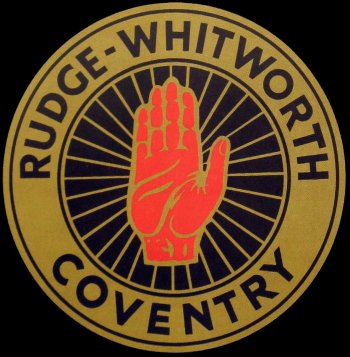

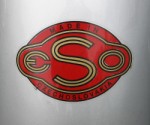


 |
|
|
|
|
|
|
|
Bikes Page 5
|
| |
| |
|
Bikes Page 1
Bikes Page 2
Bikes Page 3 Bikes
Page 4
Bikes Page 6
Bikes Page 7
|
| |
|
| |
| |
|
Ivan Mauger's
Famous Bikes
|
| |
| The following bike pics are shown with Ivan's permission.
They
are part of the "Ivan Mauger Australian Museum", which you can visit here
www.ivanmauger.com |
| |
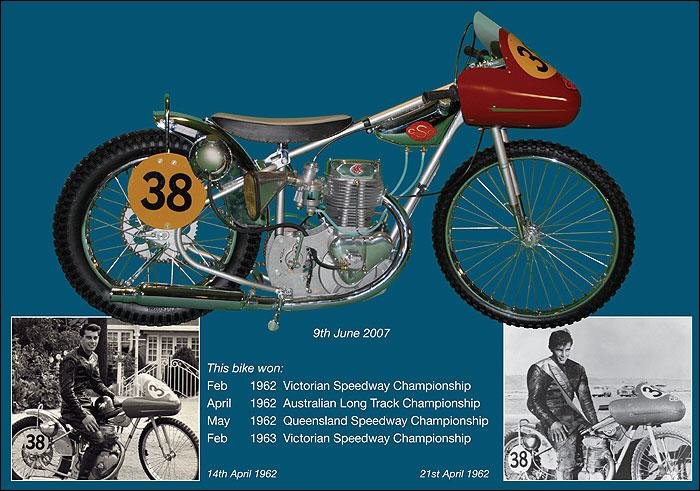 |
| |
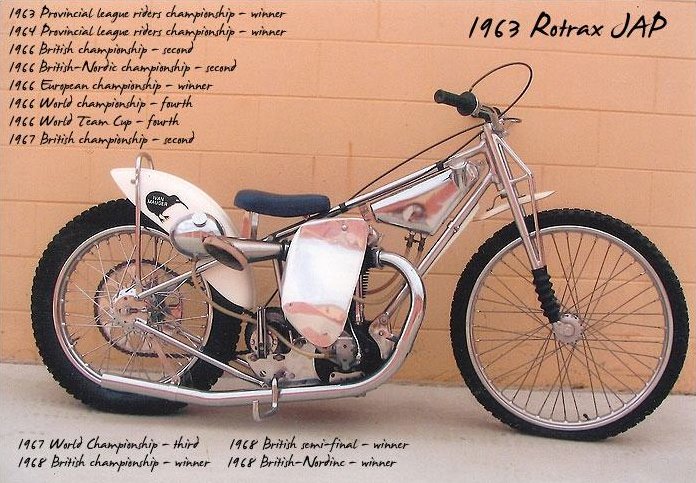 |
| |
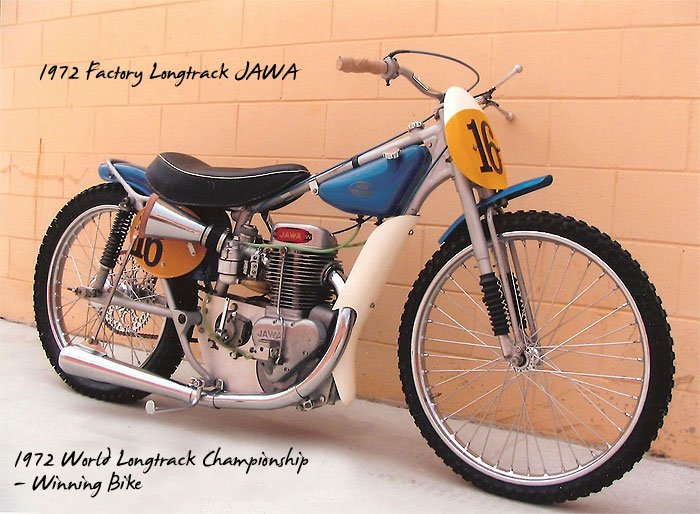 |
| |
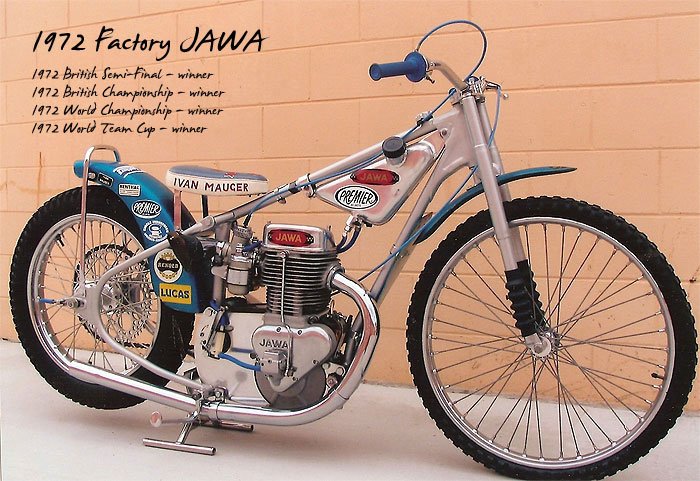 |
| |
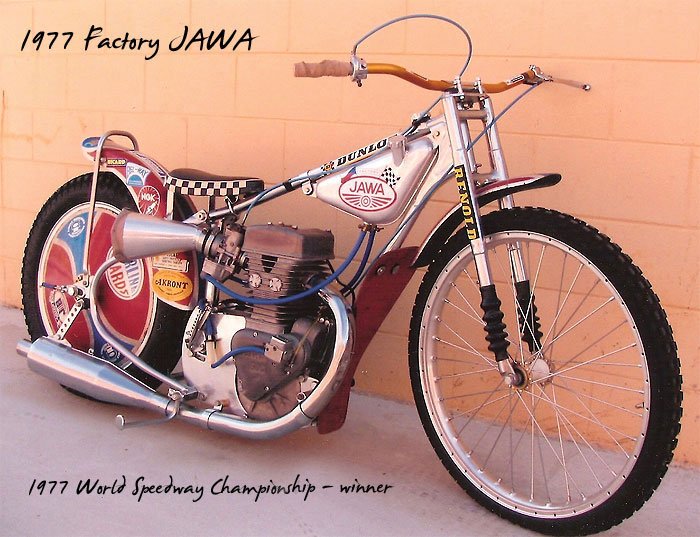 |
| |
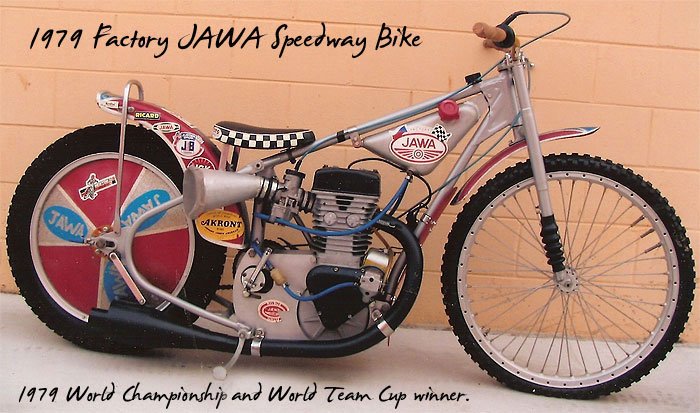 |
| |
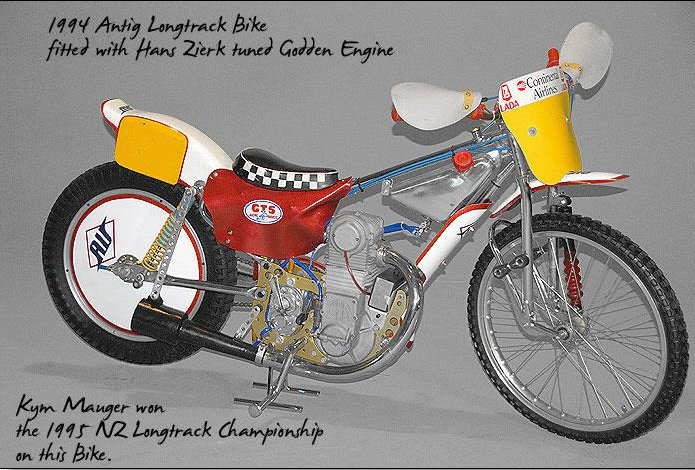 |
| |
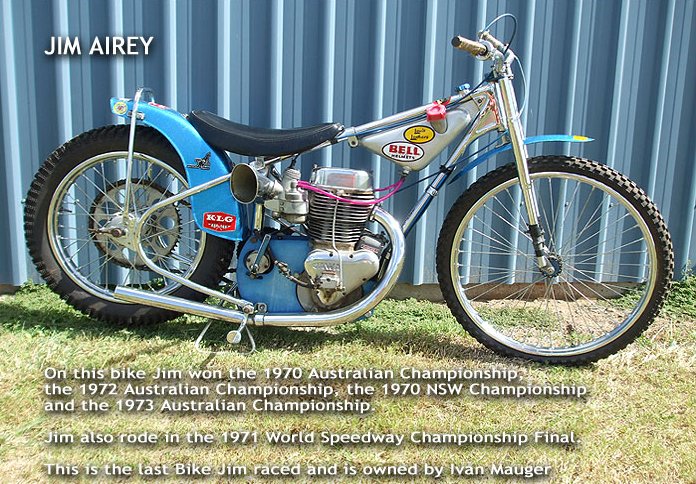 |
| |
|
Steve Magro says: The pic of Jim Airey's bike which at the time was
owned by Ivan Mauger, says Jim won the 1973 Australian Championship.
This is in fact false, as John Boulger won it that year.
However, Jim Airey did win the 1973 NSW Championship in 1973, I
assume on that bike. It was the night Jim retired and the venue was
the Sydney Showground. Geoff Curtis was also killed in that same
event. |
| |
 |
| |
|
Ivan Mauger says: Gordon and
Jim rode for Mike Parker at Sunderland in 1964,when that closed they rode for
Mike at Wolverhampton. Jim later rode for Sheffield and Gordon at Poole. Both
rode at Brough Park several times each season. Gordon was killed in 1970 at
Liverpool near Sydney. |
| |
| |
Ivan Mauger
"A Works Weslake Rider" |
| |
| |
|
Ivan's Weslakes
|
| |
| Ivan's
great talent meant he was in constant demand for all manner of things.
During 1981-1984 Ivan was a "Weslake Works Rider". He had
6 machines like the one shown below. Britain's best bike of that era, ridden by the worlds
best ever rider. What happened to the great British marque? Do you know why Weslake
went to the wall?
John |
| |
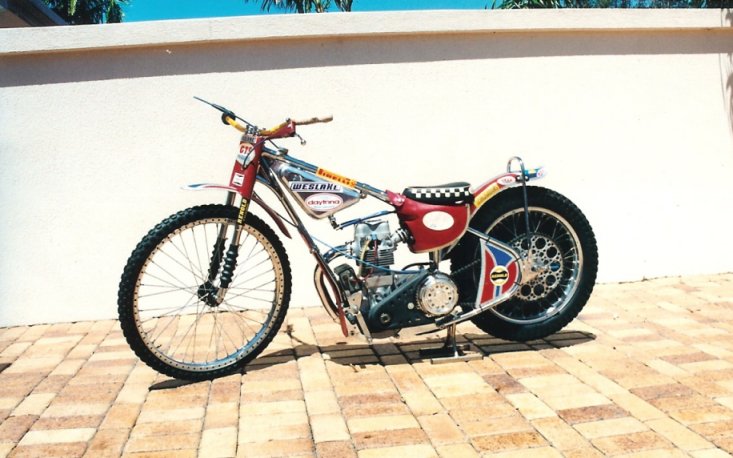 |
|
Courtesy of Ivan Mauger
"One of my Weslakes" |
| |
| |
|
One of Ivan's 1982 Weslakes
|
| |
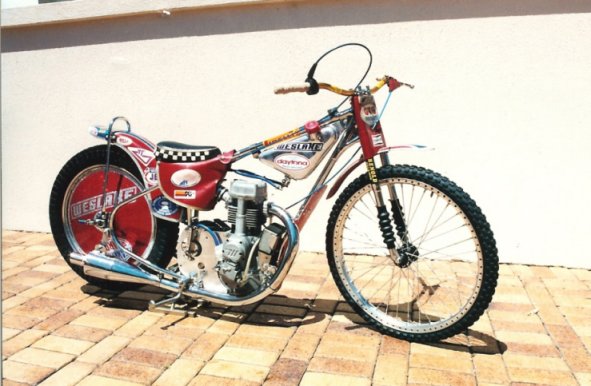 |
|
Courtesy of Ivan Mauger
|
| |
|
John says: Thank you Ivan for sending me these bike pictures. The Weslake
briefly rivalled the JAP as British machinery at it's best
|
| |
| |
Ivan In Action
On A Weslake |
| |
 |
|
Courtesy of Ivan Mauger
|
| |
Ivan says:
This action photo is of Larry Ross and me leading Kai Niemi and Olli Tyrvainen
at the Semi final of the World Pairs at Vojens on 6th June 1982.
Cheers, Ivan
What a great looking surface for racing on.
Top marks to Vojens. Ivan's Work's Wessy
leading the way. |
| |
|
| |
| |
|
Rudge
|
 |
| The
Coventry-based Rudge Whitworth Cycles company was founded by George
Woodcock in 1894, after a merger between the Whitworth Cycle Company and
D. Rudge & Co. bicycles of Coventry. D. Rudge & Co. was the result of a
merger between the Tangent & Coventry Tricycle Company and Rudge Cycles,
which was founded in 1870 by Daniel Rudge (1841—1880). |
| Rudge Whitworth produced high-wheel
(penny farthing) bicycles, notably the 'Rudge High,' and safety bicycles
until 1909, when the company entered the burgeoning motorcycle market.
Daniel Rudge's company retained its value long after his death, due
primarily to his invention of the adjustable ball-bearing (patent #526). |
| |
| So with Rudge we have a bicycle
pedigree and from 1911 a manufacturer of early motor bikes. The Rudge
'Ulster' was introduced in 1929, and was one of the company's most
famous models. The Ulster was named after Ulster Grand Prix winner
Graham Walker who won with an average speed of over 80 mph. The
following year the company also introduced two models using J.A.
Prestwich (J.A.P.) engines; a 250 cc model and a parallel 4-valve 350 cc
model. |
| |
 |
| Courtesy of The World of
Motorcycles |
| |
| A Rudge frame housing a 500cc JAP
engine |
| |
| |
| Rudge Engine |
| |
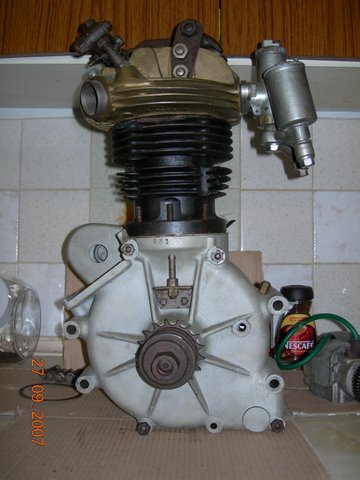
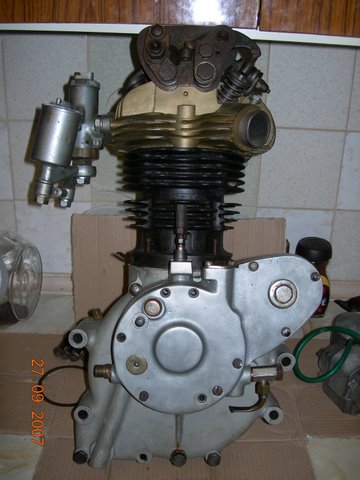 |
|
Courtesy Les Medland
|
| |
|
Les Medland says: Hi John. This Engine has the
wrong Cylinder Head fitted but I thought it maybe of interest to you. I bought
it in the mid 1960s in Plymouth from a Chap called Vic Skinner. (any
relation) He used it to Sidecar D/Track race with his brother. It's a 1930/31
Works Long Stroke Rudge Dirt Track 500 Engine. Les Medland. |
| John Skinner says: Wouldn't
it be great if I could say Vic Skinner was my uncle! Sadly he is
not! What a pity Rudge could not keep the ball rolling after the
early 1930s with investment in speedway. |
| |
|
| |
| |
|
The Dutch Museum
|
| |
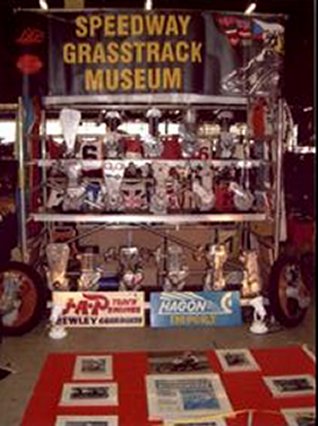 |
|
Courtesy of Koos Meijer
|
| |
|
Koos Meijer says: - I send you a
picture from the engines ot the Speedway-Grasstrack-Museum-Holland. The museum
has a collection of 33 different engines and 15 compleet bikes. Bikes and
engines with a lot of history. Big names have done donations, like Erik
Gundersen, Ivan Mauger, Egon Muller, Peter Collins, Hans Nielsen and more. The museum is in the north of
Holland near the German border. The place is called Winschoten. Full
adress is: |
Speedway-Grasstrack-Museum-Holland
M.J.van Olmstraat 35
9672 AE Winschoten
0031-652637994 |
| |
|
| |
| |
Reg Fearman's
1948
Gear Ratio
Chart |
| |
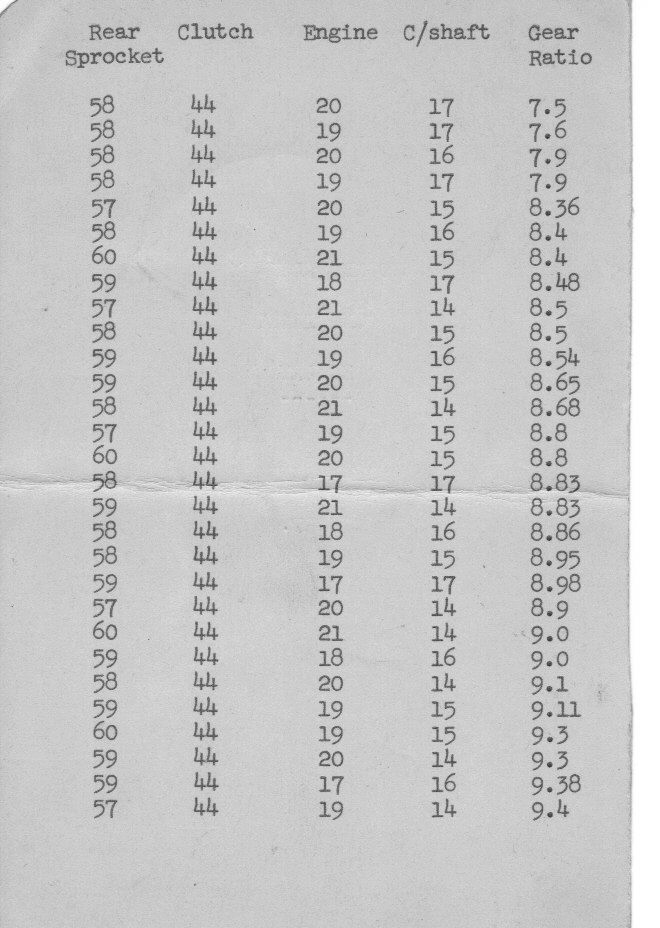 |
| Courtesy of Reg Fearman |
| |
|
Reg's Gear ratio chart as used by him in 1948. Is the info useable with
today's machines? Riding the tracks has always been a balance between the
skill of the rider and the technicalities of set ups of the machines. The
best riders possessed mechanical know how or employed someone who did the
business with the bikes for the rider.
|
| |
Bob Andrews says: From memory I think Reg must be about
right? 8.95 on a JAP. To get it, you divide the teeth of the front sprocket into
the teeth on the clutch. Then divide the sprocket behind the clutch into the
back sprocket. Then multiply the two answers together. So 20t on front into 40t,
on clutch is 2.15t clutch into 60t.back is 4. Multiply 2X4 is 8.00. (But
clutches were 44t.) But I suppose you already knew that.?? Bob
Nah I know nothing! but I am impressed that
setting up a bike is left to a rider/mechanic who may change the set up
before a riders next race.
Giffy says: Hi John, if the memory serves me right at
Brough we pulled a gear ratio of 8.8 to 1 on the JAPS and 9.3 to 1 on the two
valve Jawa, regards old mate, giffy
Rob Best says:
I have just asked Clarkie
(Roy Clarke) what they are running this year (2009) at Brough and its 62 as its
so slick. |
| |
| So where does this get us? I
can hear the yawns from my websites browsers who are not into teeth on
sprockets etc even if I am interested in it Ha Ha! |
| |
|
| |
| |
| Ivan's 1970 Jawa |
| |
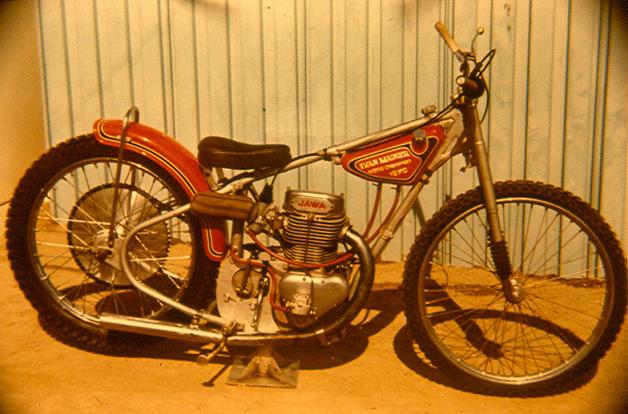 |
|
Courtesy of Dave Gifford
|
| |
Dave Gifford says: This is the bike that
"Sprouts" (Ivan Mauger), rode in the US in 1970, a two speed two valve Jawa. The
bike was owned by Dan Cotterman and tarted up by George Wenn for Ivan to use.
The inscription on the tank reads, Ivan Mauger, World Champion, 1970. Giffy
John says: Hi Giffy, Not many 2 speed speedway bikes around. I presume the low gear was
used for starts and the bike ran the rest of the 4 laps in the higher gear? |
| |
|
Cary Cotterman says: I was looking at various speedway
websites and happened to run across a photo I took (passed on to you by Dave
Gifford) on your site of the 2-speed Jawa Ivan Mauger rode in the U.S. in 1970
(with the orange fuel tank that has 'Ivan Mauger, World Champion,
1970' written on it).
Your question after Giffy's description asks how the two speeds were used.
|
| |
|
Cary Cotterman
continues:
On speedway tracks up to normal size (400 meters or shorter), only the second
(higher) gear was used, and the bike was just left in that gear all the time
and ridden just like a single-gear bike. On long tracks (like the 800-meter
Ascot Park near Los Angeles), sometimes the lower gear was used to start, then
the bike was shifted into the high gear for the remainder of the race.
This particular bike was a 1969 model, bought new by my dad, Dan Cotterman, for
$900.00. George Wenn indeed 'tarted it up' with his tuning expertise, and the
custom paint job was by Molly. After Mauger was finished with it, I bought it
from my dad, rode it during the 1971 season in California (mostly
disastrously), and sold it in 1972. I don't know what ever happened to it
after that.
|
| Cary Cotterman
says:
Great website! Love the photos of all the speedway machines! |
| |
|
Cary Cotterman
Redlands, California
USA
|
| |
| John says: Hi Cary, thank you for
the info. I am delighted that you enjoyed browsing the website.
I love the old bikes pages too. |
| |
| |
The USA's
Cary Cotterman Section |
| |
|
Cary's Unusual
1955 JAP!
|
| |
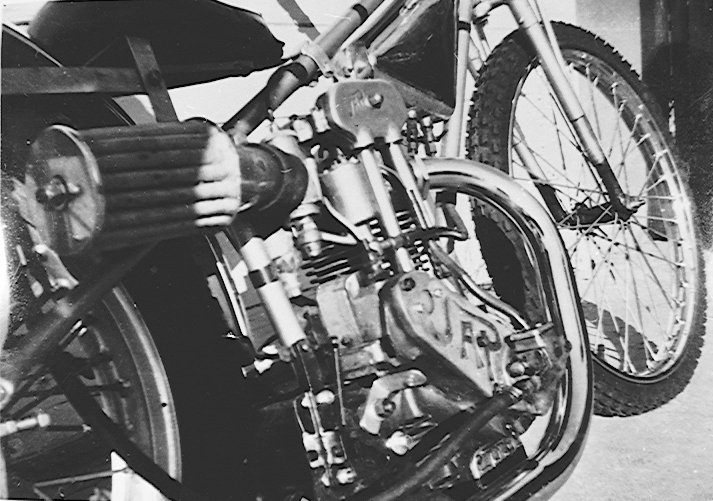 |
| |
|
John says: The cylinder barrel is shorter than a normal 50's JAP and I love
the big airfilter not seen on JAPS to my knowledge
|
| |
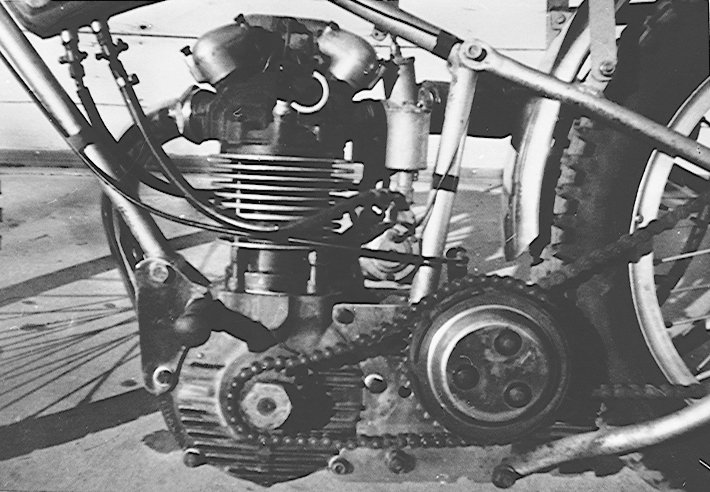 |
| |
|
John says: This shot does not look like a JAP at all,
The cylinder is very short, but what is it?
|
| |
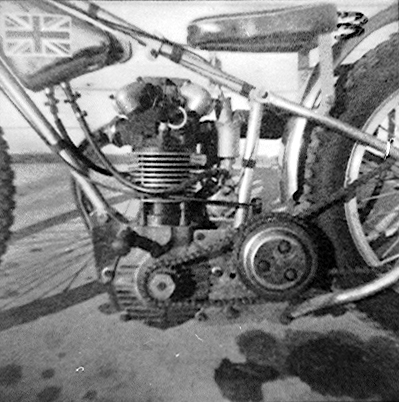 |
| |
|
John says: It's definitely not a Jawa/Eso their barrels are squarer, and we are
told it is a JAP?
|
| |
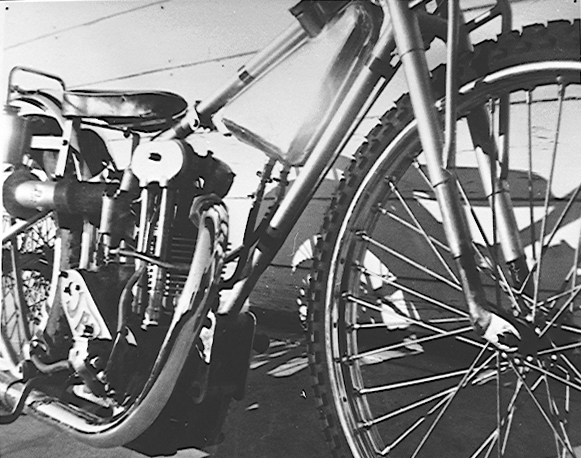 |
| |
| John says: Now from this angle I
would say it's a JAP, but the photos from the
other side baffle me. It looks like two different bikes to me! |
| |
|
Cary says: Hi John,
I found some negatives of that JAP I was telling you about with the unusual
cylinder, and scanned them (his 4 attachments are shown above).
Unfortunately they are not very good quality, but I think you can see
enough. If you look closely at the cylinder barrel, you can see it's not a
stock JAP type. Have you ever seen one like it? I don't think it's a one-off
that some fellow made in his garage, because like I mentioned before, I saw
another one like it in a photo of Jimmy Gooch from the early '70s.
I bought this JAP for $500.00 USD in 1970 from a guy who told me it was a
1955. I don't know the engine serial number, so I have no way of verifying
its age. I guess that's a Rotrax frame and forks, although I don't think the
rear mudguard is the proper original one. As a novice I found this
machine to be a monster to control and I soon replaced it with that
ex-Mauger Jawa you have a photo of on your site, which was easier to ride.
The JAP was beautiful to hear, though!
Cheers,
Cary Cotterman
|
| |
John says: Hi Cary, Whatever this bike is, it is beautiful none the less. We talk of
long stroke JAPs, maybe this was a short stroke model? I will ask around
John
Suggestions please!
|
| My friend Terry Stone from down
south says: "On viewing
your JAP on defunct speedway I think the barrel on the engine. It may
be a COOPER CAR barrel. Hope this is correct. If you have had any other comments
on this do let us know". |
| John says: any further comments
will be shown on this webpage |
|
Dave Gifford says: Hi John mate. hope all is well with you and things
are getting warmer. re the JAP, it just looks like a normal 4 stud motor
with a home made cylinder barrel to me. I don't think the stroke has been
altered judging by the gap between the inlet rocker cover and the frame. It
was a simple job to make a barrel either from a casting or a solid billet.
That's my guess for what it's worth. take care, giffy |
| Bob Andrews says: Hi John. Well it's not a Rotrax frame, The Motor
has a short barrel on it. Ronnie Moore had a shortened JAP that he took over
to England in about 1968 that was given to George Greenwood and they made a
short JAP copy of it to sell. It "revved" a lot. It was to try and match the
E.S.O. ( Jawa) But it never caught on. So some one has put a shorter Con Rod
in this motor and was a little earlier than Ronnie's Hope that helps.
Regards Bob. In the Ronnie Moore Book by Rod Dew. the first chapter ( I
think) Tells of Ronnie winning the N.Z. Champs at Palmerston North, and in
the race against me.( I got second) Rod writes that Ronnie was on an "old"
1947 JAP and beat me and that I had the latest equipment. But I also had a
1947 motor. as they were the year when they very best. Flywheels were
made and that gave them their speed. But Ronnie's bike had the short rod and
had been worked on by the speed gurus in Christchurch and he had a far
superior bike. But of course it made great reading and Ronnie was the hero
in the story. |
|
Jim Henry says: Is it a
350cc JAP? JAP's of this capacity were built for grass track racing. |
|
Pete Gay has sent this picture (below) and says:
Hi John think the cylinder is off a Cooper JAP, (2nd vote for the
Cooper) |
| |
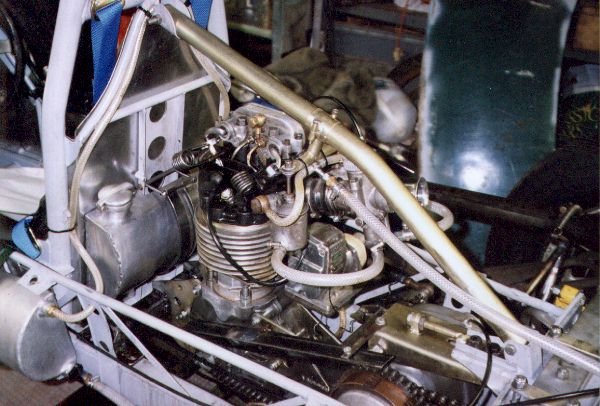 |
| |
|
John says: It is very likely that Terry and
Pete are correct, unless of course you know better, if so send me an email
John
|
| |
| Cary Cotterman, the past owner of the "unusual" Jap has
read the above suggestions and has this to say about his unusual JAP:
|
| |
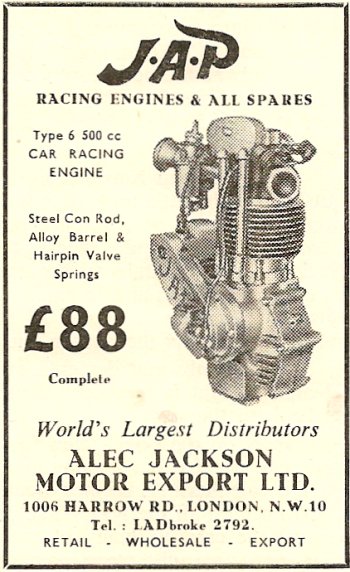 |
Cary says: Well,
John, since I emailed you a short while ago I've done some research
based on the idea that the cylinder barrel on that JAP might have
been like one used in a Cooper racing car. If you
go to www.500race.org/marques/JAP.htm and
scroll down a short way, there's an old advertisement on the right side
for a JAP 'Type 6 500cc car racing engine', which I have attached to
this email.
The
barrel in the photo is rounded and has ten cooling fins with polished
edges, exactly like the one on my JAP bike. The advert even says the
barrel was alloy, which was also the same as the one on the bike.I
feel on the verge of concluding that someone replaced the stock barrel
on the bike with one from a Type 6 car racing engine (or, even more
bizarre, perhaps the entire engine in the bike is one of the car racing
engines?).
Best,
Cary John says:
Hi Cary, Thanks for this very
interesting section. I think that we have identified, via the
website, your old bikes engine. It was a "Cooper JAP", How did it
go by the way. Could it keep up with the conventional bikes of the day.
and do you have any data about how it performed in a car? I
presume the cars would have used gearboxes with the engine
John
Cary says:
Hello John,
As to your question, 'how did it go', I can only reply
that I was a mere novice rider with very limited ability and I had only ever
ridden one other JAP, very briefly, so I don't have much of a foundation for
judging. It seemed to me to have a lot of power, but that sensation could be
attributed largely to my lack of experience. As I mentioned before, it was
much more difficult to ride than the 2-valve Jawa I switched to. Cary
|
| |
Pete Gay says:
HI John just had another look at the first photo and I think
the engine my have come out of a Cooper, if you look at the Mag cover the hole
and mounting bolts are there for the rev counter cable.
|
| |
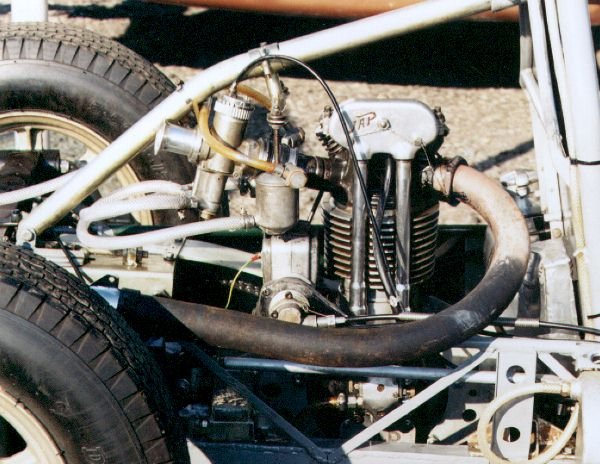
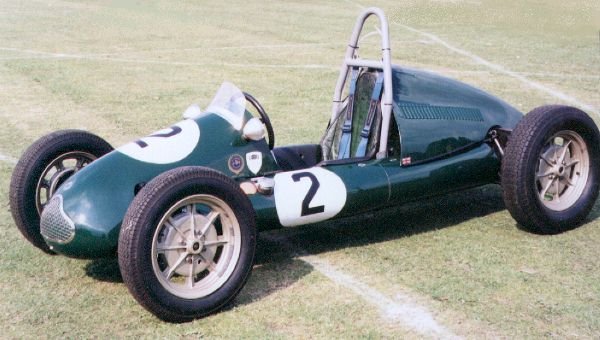 |
| |
500cc Jap engine fitted in the Cooper.
Pete Gay says: It was the start of the
Cooper race cars , then Mini Cooper S and today we have the BMW Cooper.
|
| John says: British engineering was
so good in the first half on the 20th century. A link between JAP
and Cooper is very interesting. I am a little bit unsure that a
500cc car class was worth the effort? but doesn't the little car look
good? |
| |
|
| |
| |
|
1960's Rotrax
JAP
|
| |
| Now! regular visitors to my
websites will know that I am a fan of Rotrax JAPs. The photo below
shows a gleaming example of the best looking speedway bike ever made! |
| |
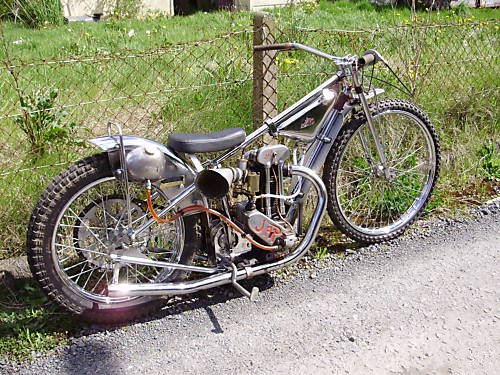 |
| |
| There are plenty of examples of
Rotrax JAPs like this one from an age when chrome plating was the
preferred finish for steel. The chromed British JAPs were
beautiful for us petrol heads! Modern speedway bikes just don't
measure up to the JAPs to look at. Also the long cylinder upright
engines have the edge over lay downs. Sadly engineering has
progressed over the years and the older technology had to give way to
the modern machines which just don't look as good, they do however
perform much better than the chromed dinosaurs of the 1950s and 1960s.
|
| I am a fan of the JAP and the ESO/Jawa
that replaced it. The upright Czech bikes also looked good
compared to the modern laydowns. |
| |
|
| |
| |
|
Giffy's Restoration
|
| |
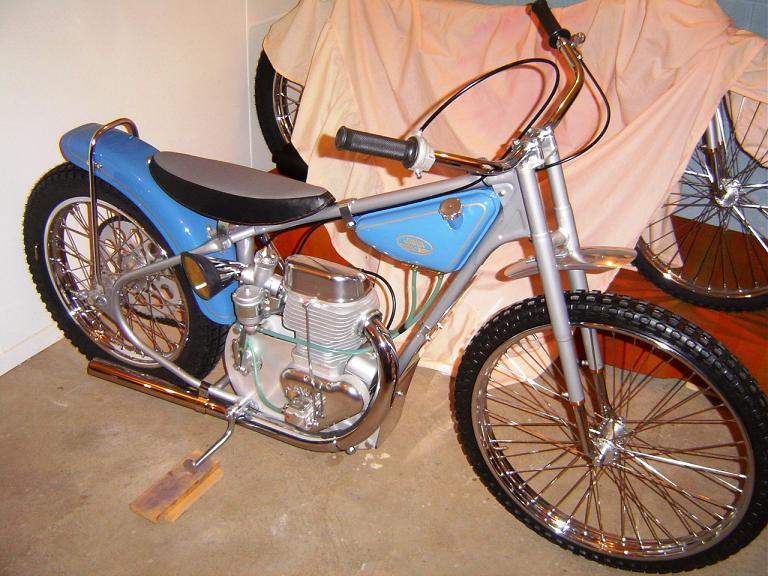 |
| |
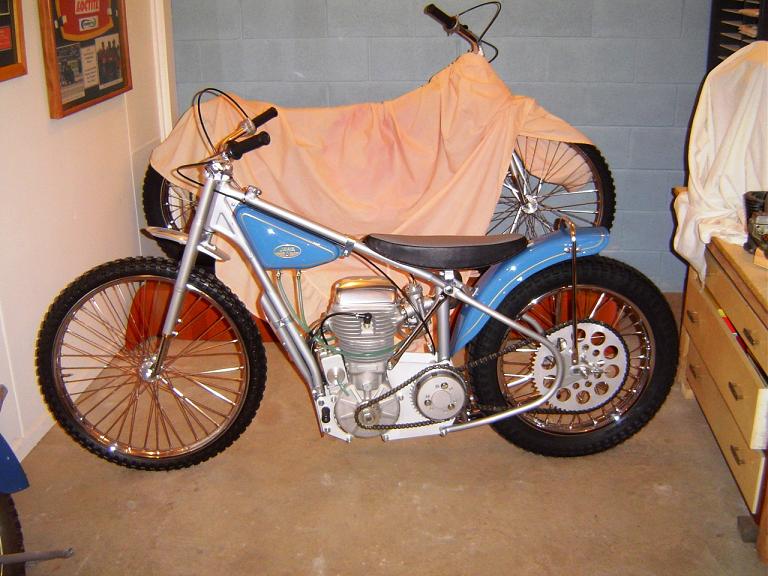 |
| |
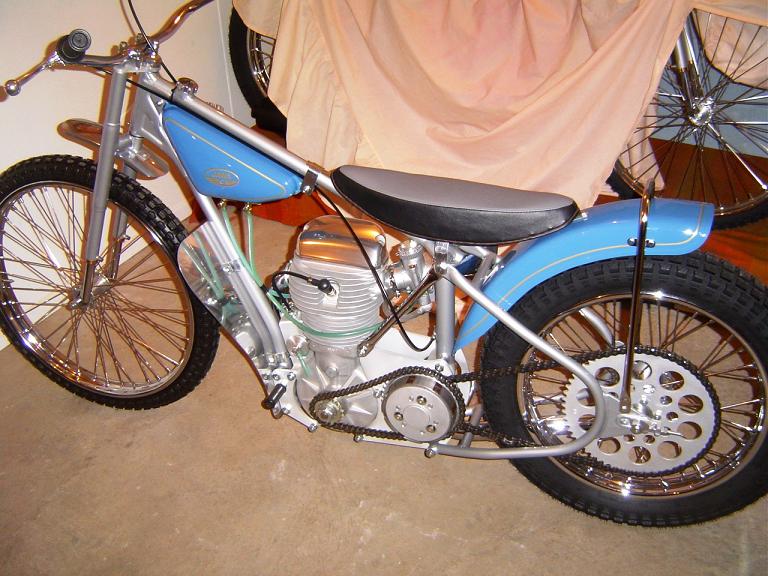 |
| |
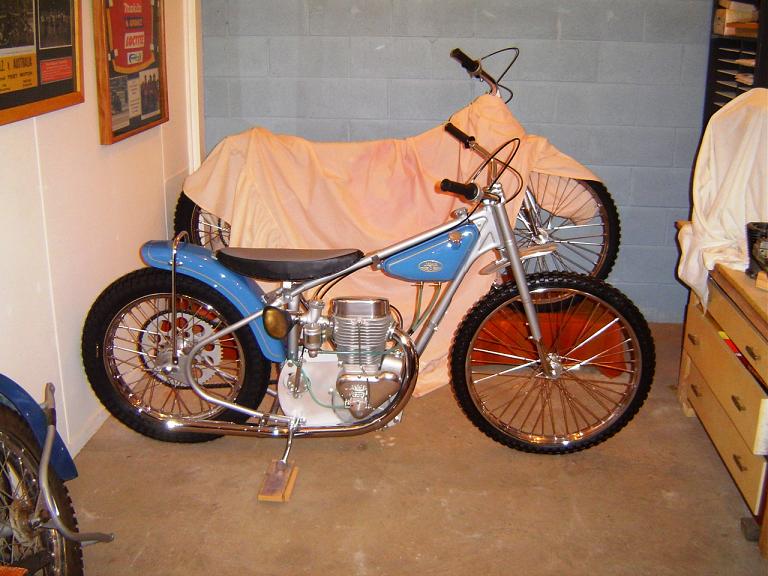 |
| |
|
The Blue Jawas are courtesy of ace restorer Dave Gifford
|
| |
|
| |
| |
Speedway Engines From
Alf Busk A
Danish Collector |
| |
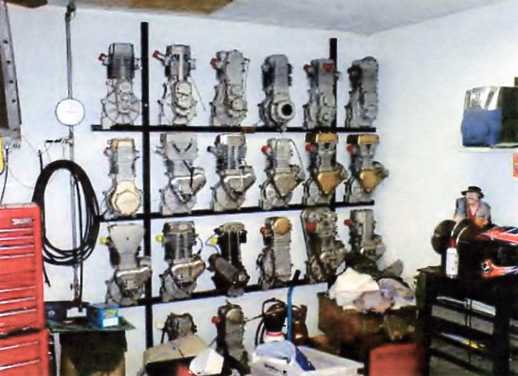 |
| |
| Below: 2 pictures from Denmark the sender is building a Godden drag
bike for the drag race series over there. In the course of the e-mails he sent
me a photo from a friend of his who has a collection of speedway engines on the
wall of his garage (see above). |
Jan Staechmann says: Hi
John, The picture you have from Denmark, with a collection of engines on
the wall, is my friend Alf Busk’s collection, who used to ride for a.o.
Coventry. Great website John Cheers
Jan
Thanks for the assistance Jan, John |
| |
| |
| A Hybrid Engine |
| |
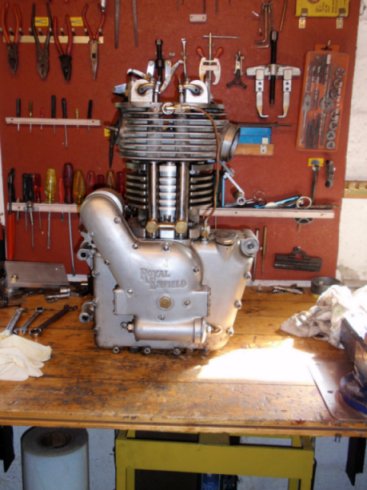 |
| |
| A picture from Denmark showing a Jawa crank, barrel, and head grafted to a Royal
Enfield crankcase. This machine is run in some sort of drag racing "street" class over
there. |
| |
|
| |
| |
Jack
Winstanley's
LFS
(Louis Foster
Special) |
| |
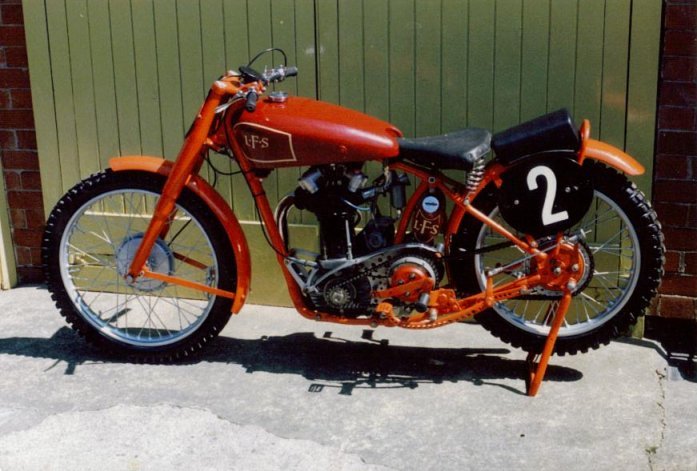 |
|
Courtesy of George Winstanley
|
| |
| Jack rode for Newcastle 1948 and
again in the early 1960s. He could turn his hand to anything and
his son George has sent me the image of Jacks Sand Racer shown above. |
| |
| |
| Jack's Son George Winstanley |
| |
 |
|
Courtesy of George Winstanley
|
| |
|
George
Winstanley says: Here's a pic of
me aged 13/14 on my 150cc Villiers grass bike. I was a member of the Lancashire
grass track junior riders club. |
|
John says: Young George astride a Villiers-engined grass-track
bike. I had a Villiers engined James Captain when I was 16 in 1968 with the same flywheel magneto engine. Villiers
and Jap were the UK's independent premier engine makers and the two companies joined forces
but couldn't stave off the Honda led Japanese invasion in the late 1960's. |
| |
|
| |
| |
Godden NZ Longtrack
Winning Bike |
| |
 |
|
Courtesy of John Abel
|
| |
|
Ivan Mauger and son Kym's
Aussie/NZ Han Zeirk Godden Antig. Kym won the New Zealand Long Track
Championship on this bike.
|
| |
|
| |
| |
|
1976
World Long Track Championship Winning Bike |
| |
 |
|
Courtesy of John Abel
|
| |
|
1976 World Championship Long
track Bike -First 4 Valve Jawa Engine to be raced and win on debut. Eng No
001.[Background light spoilt this photo a bit.]
|
| |
|
| |
| |
|
Ivan's Gold Bike
At
Home
After
Restoration
|
| |
 |
|
Courtesy of John Abel
|
| |
Ivan Mauger says
Hello again John: Re the
other photos that John Able has sent to you. John was David Bargh's mechanic all the time Barghy was at Newcastle. John
now helps me restore a lot of my Bikes and as you can see
he does a great job. He done most of my 1976 Long Track bike and tidied up my
Gold bike before I put them in the Christchurch Museum in Sept 2007
Hope this helps |
| Yes it helps, thanks Ivan (and John
Able). I am really pleased about the help you are giving me with
the websites. I am amazed Ivan that it is 51 years ago that you
started riding at Newcastle way back in 1963 and I was there watching
you ride. |
| |
|
| |
| |
| Some 1930s Bikes |
| |
|
1930's Machine Possibly
A Rudge?
|
| |
 |
| |
| |
|
1930's May Be A Douglas?
|
| |
 |
| |
| |
| 1930s Scott |
| |
 |
| |
| This bike was quite technologically
advanced for the time, it was a 500cc water cooled two stroke. Two
stroke engines make a completely different noise to the more common 4
stroke speedway bikes, 2-strokes are usually a lot louder. |
| |
| |
| Possibly A Rudge? |
| |
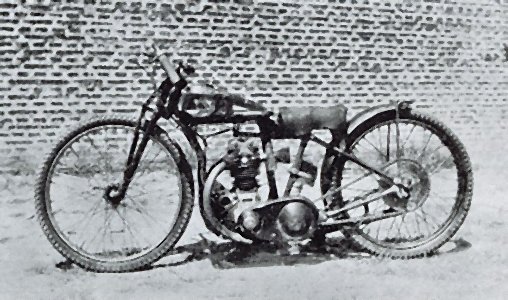 |
| |
| I think this is a Rudge but maybe
it isn't? The pic is not very clear. If
you can supply info on these 4 bikes I would be pleased to hear from you
John |
Dave Dale says:
The engine does look like a 4
valve square base Rudge engine to me. Not central spark
plug like TT Replicas, Ulsters and presumably most DT Rudges.
|
| |
|
| |
| |
| Rudge/JAP |
| |
 |
| |
|
Photo taken at the Primer Nationals, The frame appears to be half Rudge
with a newer swinging arm fitted? Also the wheels look odd but it is still
a fine looking bike.
|
| |
|
| |
| |
|
1974 Jawa
890
|
| |
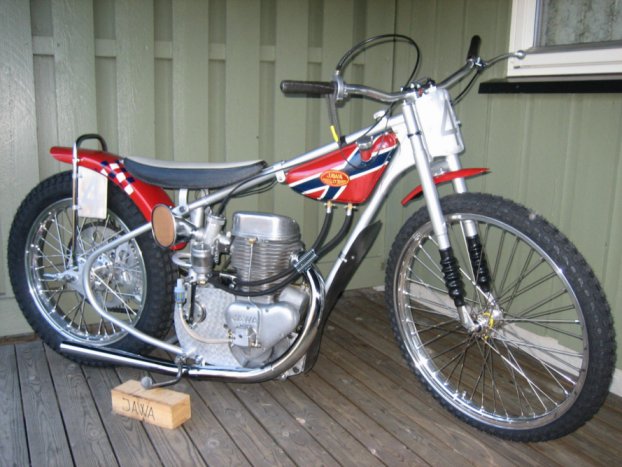 |
| |
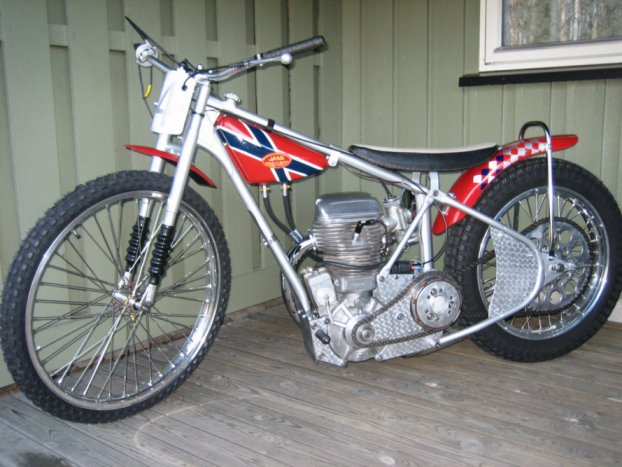 |
|
Pictures of this Jawa, courtesy of Geir Overby
|
| |
|
Norwegian
Geir Overby has restored this Jawa 890. The engine dates from 1974 and the frame
1968-74 it is beautiful to look at. Well done Geir. |
| |
|
| |
| |
|
Weslake Land Speed
Record
|
| |
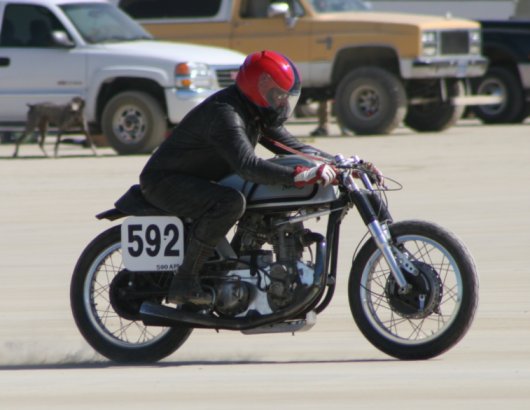 |
| |
|
Bill Anderson says: I moved home to California and started racing my
converted speedway Weslake at El Mirage dry lake.
I run it on race gas (petrol) VP C12. It holds the record there at
129.817mph. Which brings me to a question. I don't know the year of
the motor. Its not really important but I'm curious. Is there anywhere
that I could find records of Weslake motors?
Many thanks for setting up such a wonderful site.
Bill Anderson
|
| John
says: If anyone can help Bill send me an email
John |
| |
| |
|
Weslake Land Speed Record
Sidecar Racer |
| |
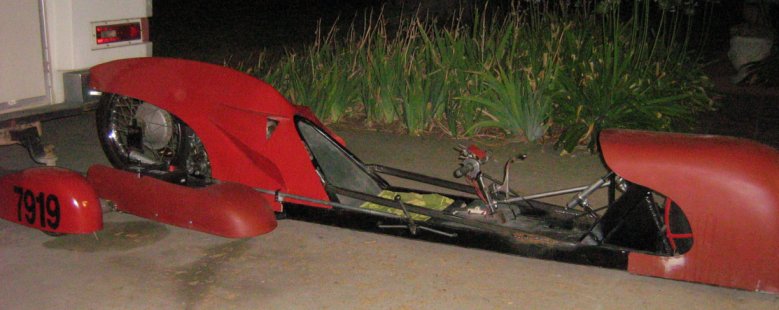 |
|
Photo Courtesy of Bill Anderson the owner of this Weslake |
| |
|
Bill says: The Weslake engine I'm using in the Norton
(see bike with number 592) has proved so reliable not to mention fast I've been building a
sidecar for land speed racing. Its a later pushrod engine. I had it in the
Norton to check it out and it ran 125mph at El Mirage. Plus several other
runs all over 120mph. Again I just thought I'd throw it in for a laugh.
I was at a speedway shop in Garden Grove on Thursday last to get some castor.
He had a nice collection of speedway machines. One that caught my eye ws a
1930 Rudge 4 valve speedway machine. I had never seen one before. I am
planning a return trip to have a closer look. I had the Weslake sidecar to
Bonneville a couple of weeks ago and had a wonderful time. The Weslake ran a
best time of 125.715 mph (202.3 Km/h). A first for it! It also raised the gas
record from 98 mph to 119.668 mph and the fuel record from 101 mph to 117.168
mph. And best of all nothing broke! |
| |
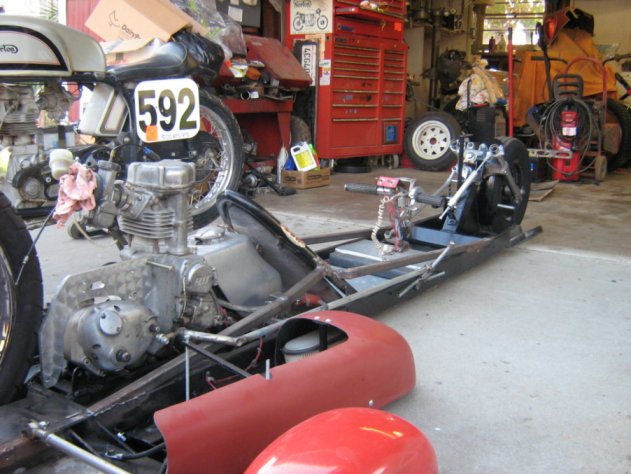 |
| |
|
If anyone else is using an ex speedway engine for another purpose, please
email me John
Bill has been in touch again about his drag bike, he has sent the two pictures
shown below. |
| |
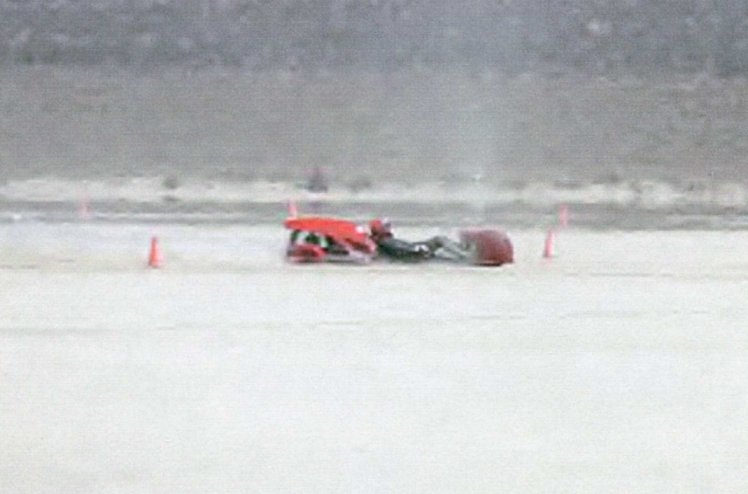 |
| |
 |
| |
| Bill
Anderson says:
I finally got the sidecar out for the SCTA El Mirage dry lake meet in
June. It failed scrutiny in May. So changes were made.
Its been out for the June, July and Sept. meets. The Sept meet was
very good. It picked up its skirt and ran to the tune of 122.240
mph (197 km/h if you are metric). There is about 15 mph left in
it. Maybe by the end of the year it will do it. You have to
love speedway singles! |
| John says:
Thanks Bill for the photos. Looking at the above pic I note that
you lie down on the job! The machine sort of echoes The Worlds
Fastest Indian |
| |
|
| |
| |
|
Weslake Engine For Sale
|
| |
 |
| |
|
Weslake engine for sale ex Anders Michanek. email
Tommy for
details
|
| |
|
| |
| |
|
Old Frame In The Republic Of Ireland
|
| |
 |
|
Courtesy of Bill Anderson
|
| |
|
Bill Anderson says:
Hello John, I stumbled across this old photo I took when living in Dun Laoghaire
many years ago. Since "discovering" your site it was rattling around in
my head. I know it's an ancient speedway frame. The front wheel is not
part of it (obviously!). It came out of the basement of a house in
Mount St., Dublin in the early 70s. The house was to be demolished so I
"rescued" it rather than see it go to the dump. I can't remember what I
did with it. I think I gave it to a friend when I left Ireland and I
think he still has it. I must give him a shout and find out. Just
thought you might like to have it for your files.
Bill
|
Hi Bill I think the frame is a 1940's Jap? some riders used a
grasstrack front wheel hence the brakedrum. I can remember
Newcastle rider Russ Dent using a front wheel like this one and that was
in the 1960's so maybe the frame is 40's but the front wheel is later.
If your friend still has the bike ask him to take a few more pictures.
John |
| |
|
| |
| |
|
Vintage Bike Auction
|
| |
|
Cheffins Auctioneers
say: Dear Sir, I thought
you may be interested to learn that Cheffins Auctioneers have consigned a
number of machines and spares from the estate of the late Sid King and
amongst other things will be auctioning on the 18th October 2008 a 1928
Dirt Track Douglas plus another dismantled (restored parts ready for
re-assembly), a c1930Rudge 4 valve speedway machine, c1932 Commerford JAP
speedway machine and a c1935 Martin JAP speedway machine, there are also a
quantity of JAP engines.
Sid King
was not a rider but seems to have been fairly well known in the VMCC and
restoration circles, he restored a number of Brooklands machines as well
as early Dirt Track and Speedway. I understand he worked for Vic Martin
(as per the bike) in 1949-50 which is where the passion for all things
JAP came from.
|
|
|
|
Jeremy V P Curzon MNAVA
Cheffins Auctioneers
Clifton House
1 & 2 Clifton Road
Cambridge CB1 7EA
01223 213777
|
| |
|
There are 5 bikes for sale as at 5th September 2008
pictures follow below: |
| |
| |
|
Lot
# 1 1932
Comerford JAP |
| |
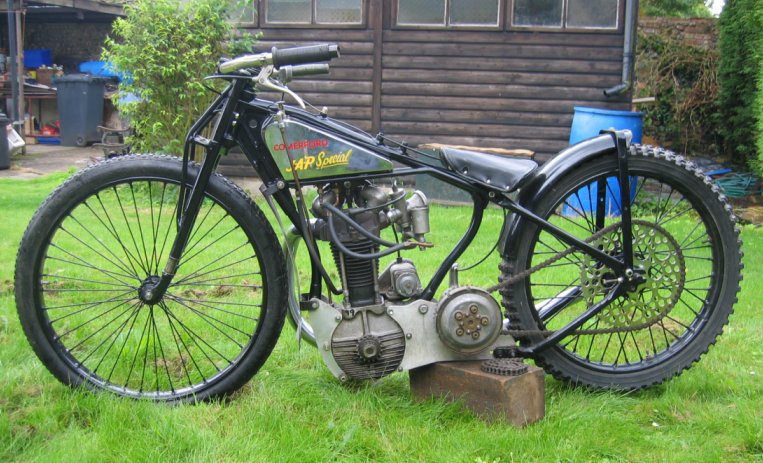 |
|
|
|
John says: The bike is beautiful despite it missing it's primary chain
which is lying on the wooden block. With the chain off the bike
would be easy to push around |
| |
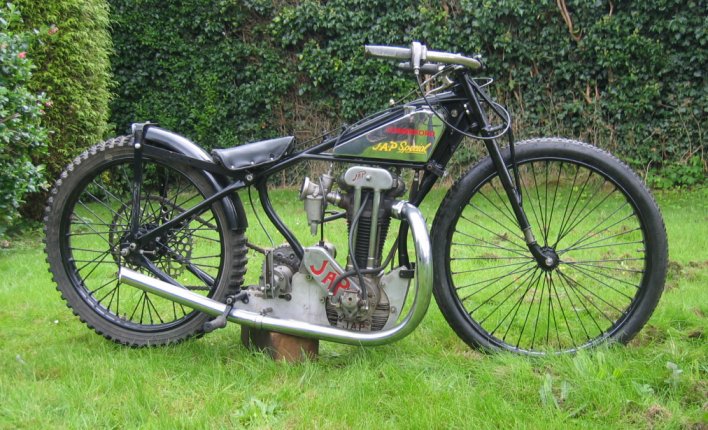 |
| |
| |
|
Lot # 2
1928 Douglas DT
|
| |
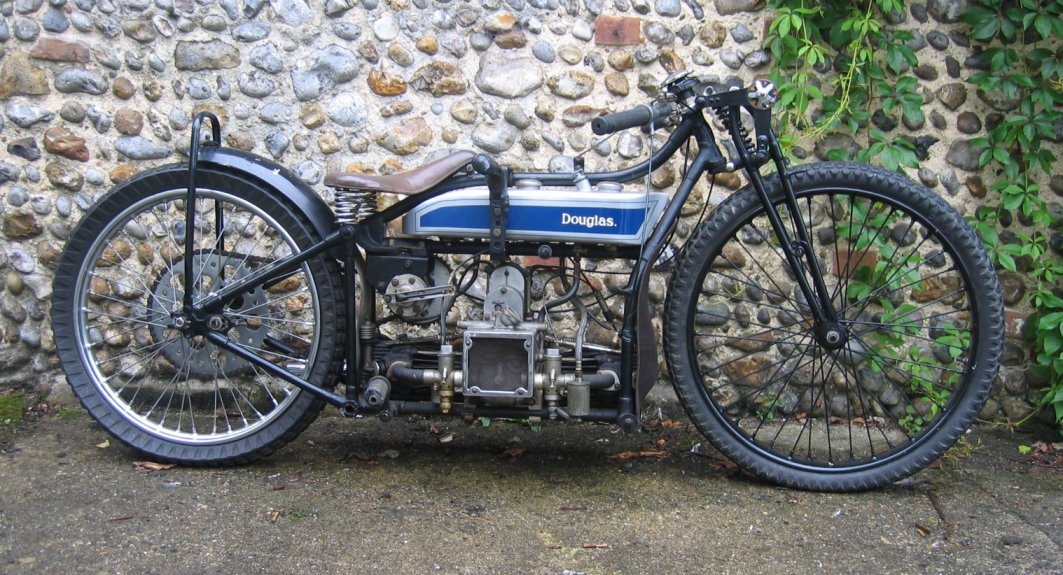 |
| |
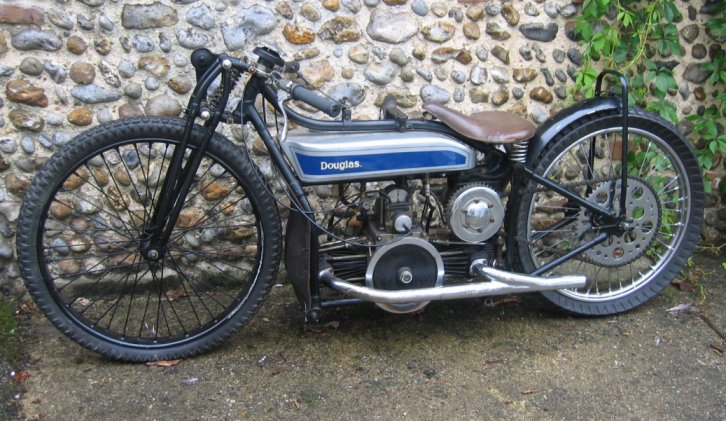 |
| |
| |
|
Lot # 3 Douglas
In Pieces!
|
| |
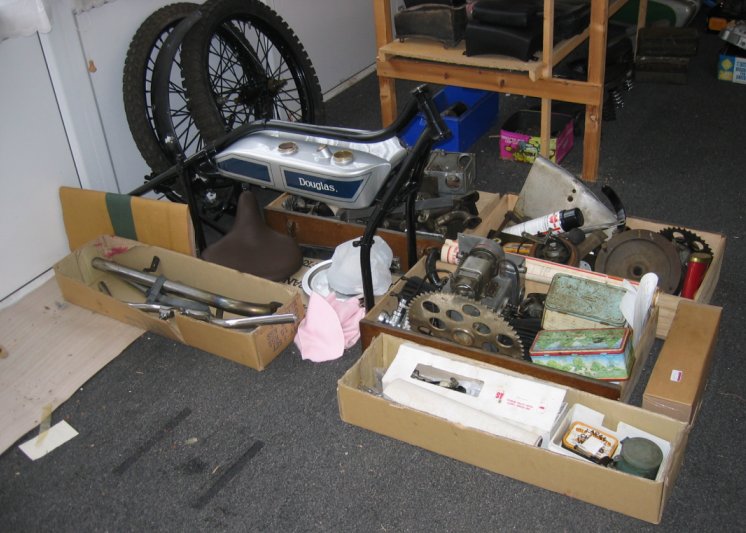 |
| |
| |
|
Lot # 4 1935
Martin JAP
|
| |
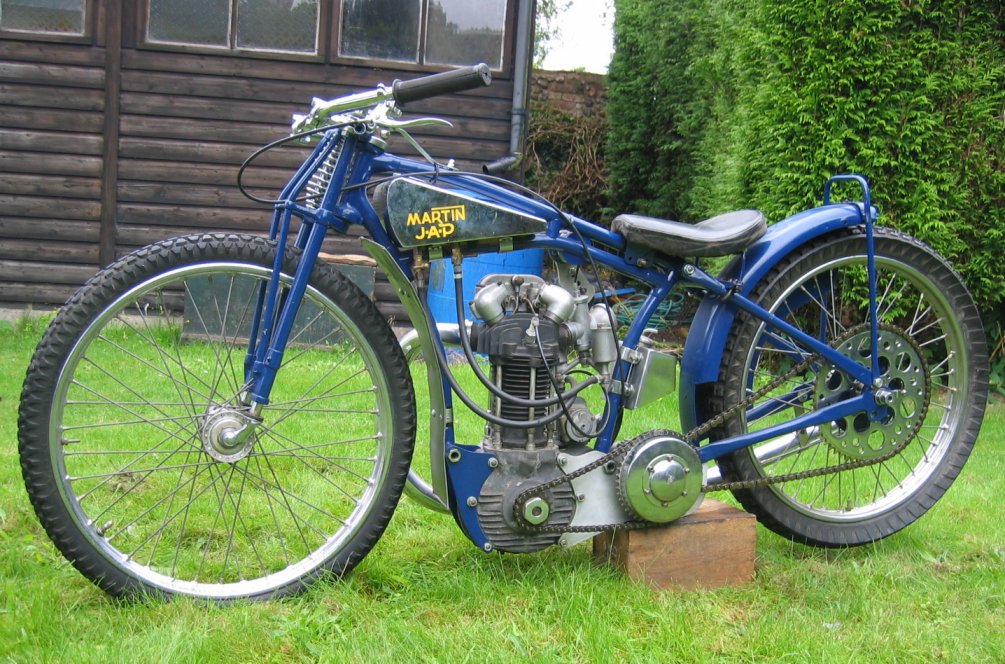 |
| |
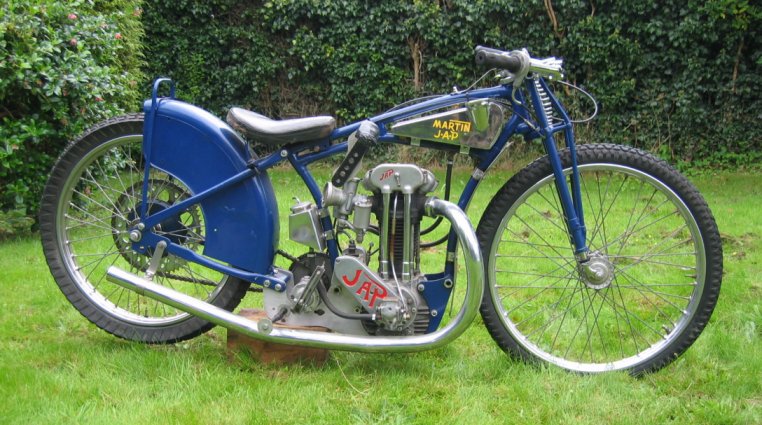 |
| |
| |
|
Lot # 5 1930 Rudge
|
| |
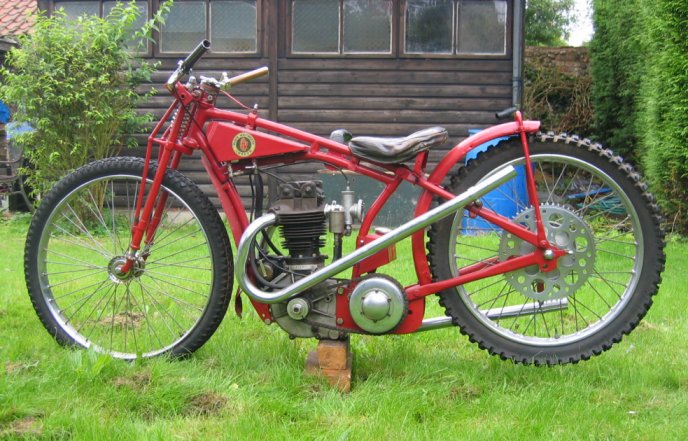 |
| |
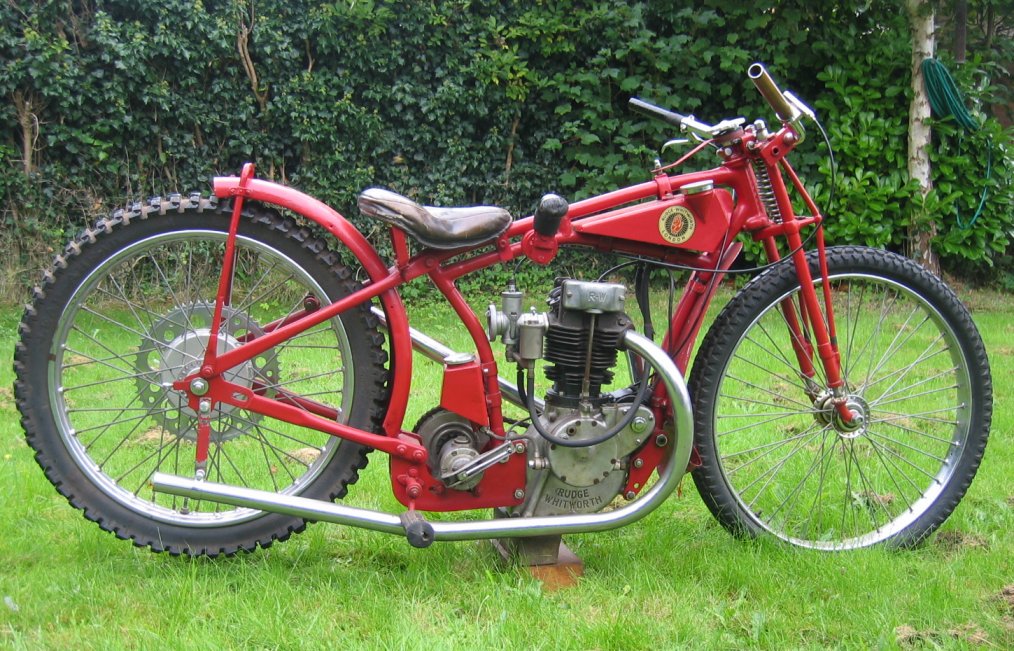 |
| |
| My thanks to the Auctioneers for
sending me the images. I hope the machines raised a lot of cash
for the owners |
| |
|
| |
| JAPs |
| |
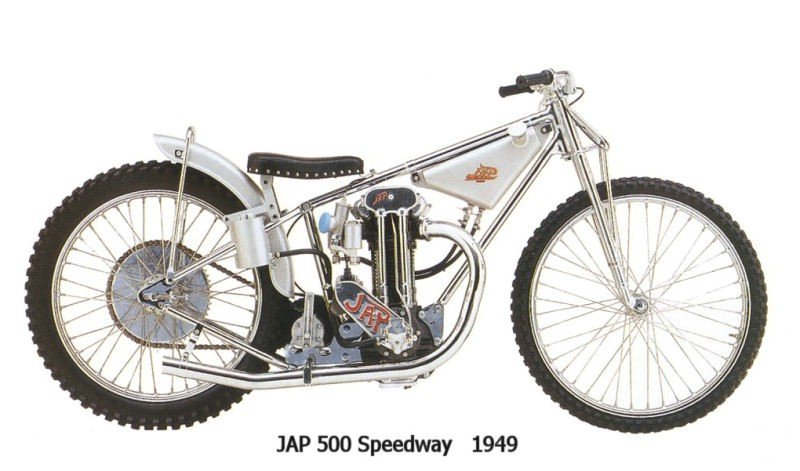 |
| |
 |
| |
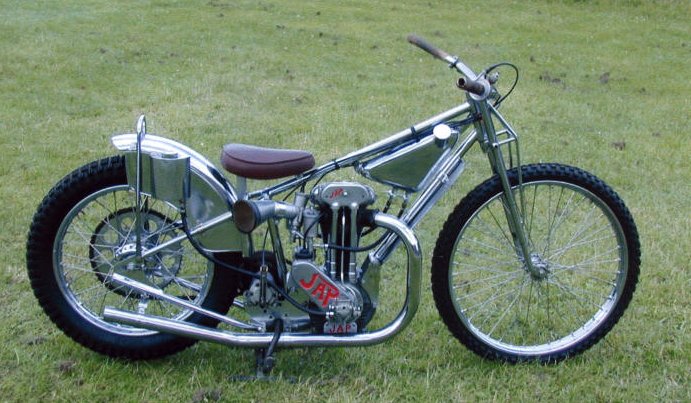 |
| |
|
| |
| |
| ESO |
| |
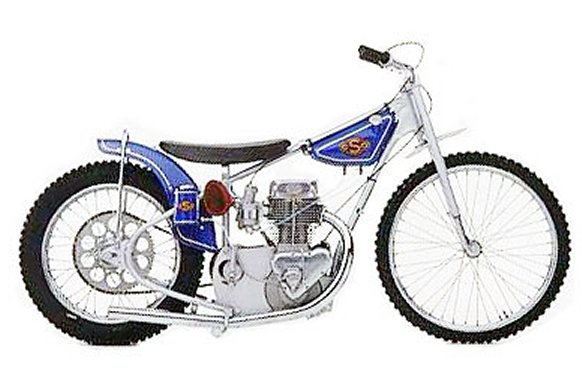 |
| |
| 1966 Eso Speedway. Czechoslovakian built. The bike that
signalled the end for the British Jap. The Eso (Czech word meaning Ace)
wasn't any faster than the Jap but it needed less work to maintain and could do
more meetings between rebuilds. The Eso firm
later amalgamated with Jawa and the Eso name was lost in favour of Jawa.
The early Jawa /Eso 890 continued to dominate for most of the 1970's.
Engine conversions such as Neil Streets 4 valve head became well known amongst
riders wanting extra power. |
| |
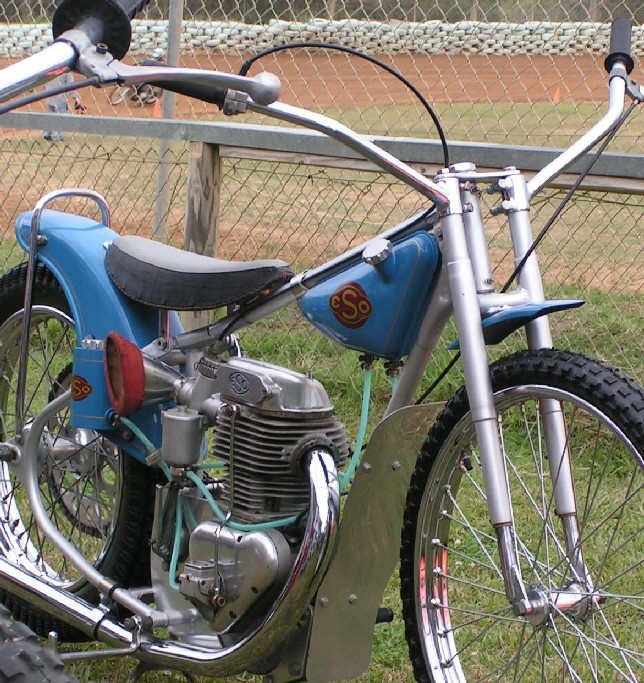 |
| |
|
A trademark of the Eso was the two-piece clip on handlebars.
British road going machines in road racing trim had clip on bars too, to let the
rider lay forward over the petrol tank
|
| The above pic shows each handlebar
had a clamp with two nuts and bolts holding them steady, probably not
very well in a heavy pile up! |
| |
|
1967 ESO Ice Racer
|
| |
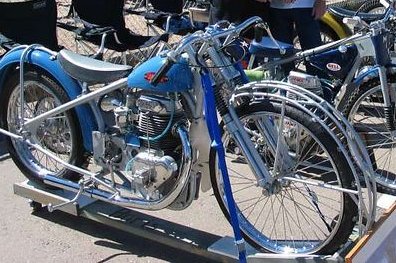 |
| |
|
| |
| |
| The Godden |
| |
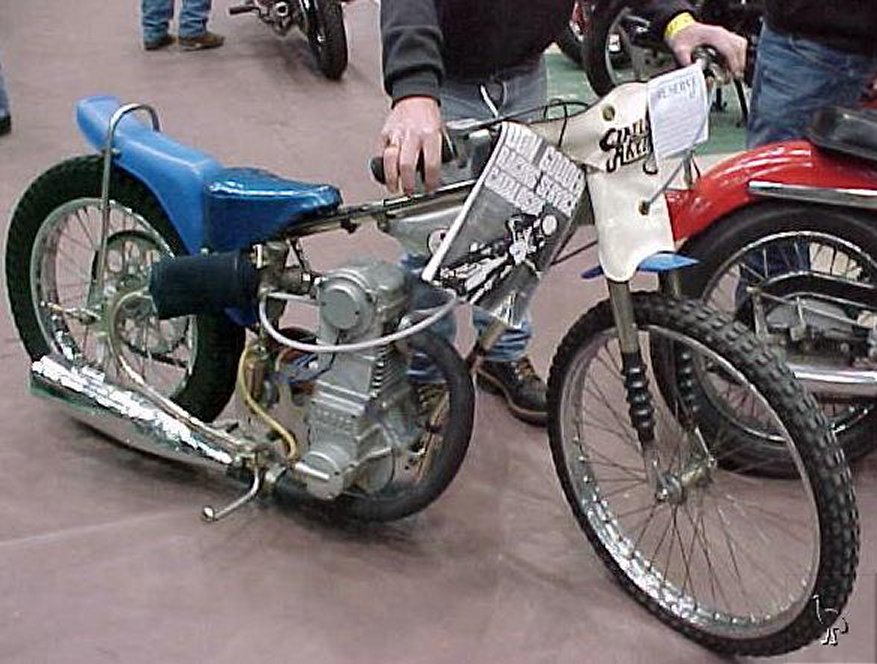 |
| |
1981 Godden Mk2
If you have any photographs or stories about
the Godden please scan and email
to me
John
|
| |
|
| |
| |
|
Weslake
|
| |
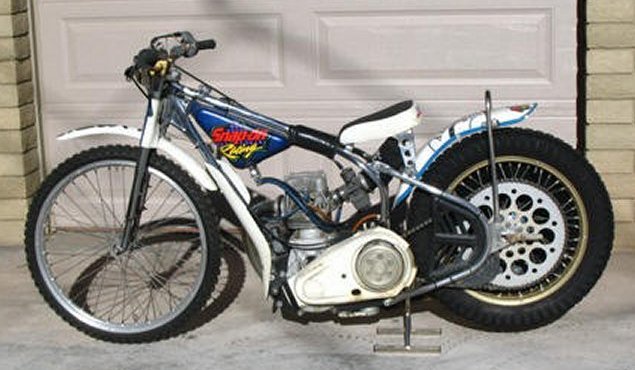 |
| |
|
1976 Weslake
|
| |
 |
| |
|
Weslake, a small British company, took on the mighty
Czech Jawa
corporation in the mid 1970's and for a few years
their bikes vied successfully with the Czech's although by 1983
Weslake had more or less had it's day. If you know why the Wessie
disappeared please let me know John
|
| |
|
| |
| |
| JAWA |
| |
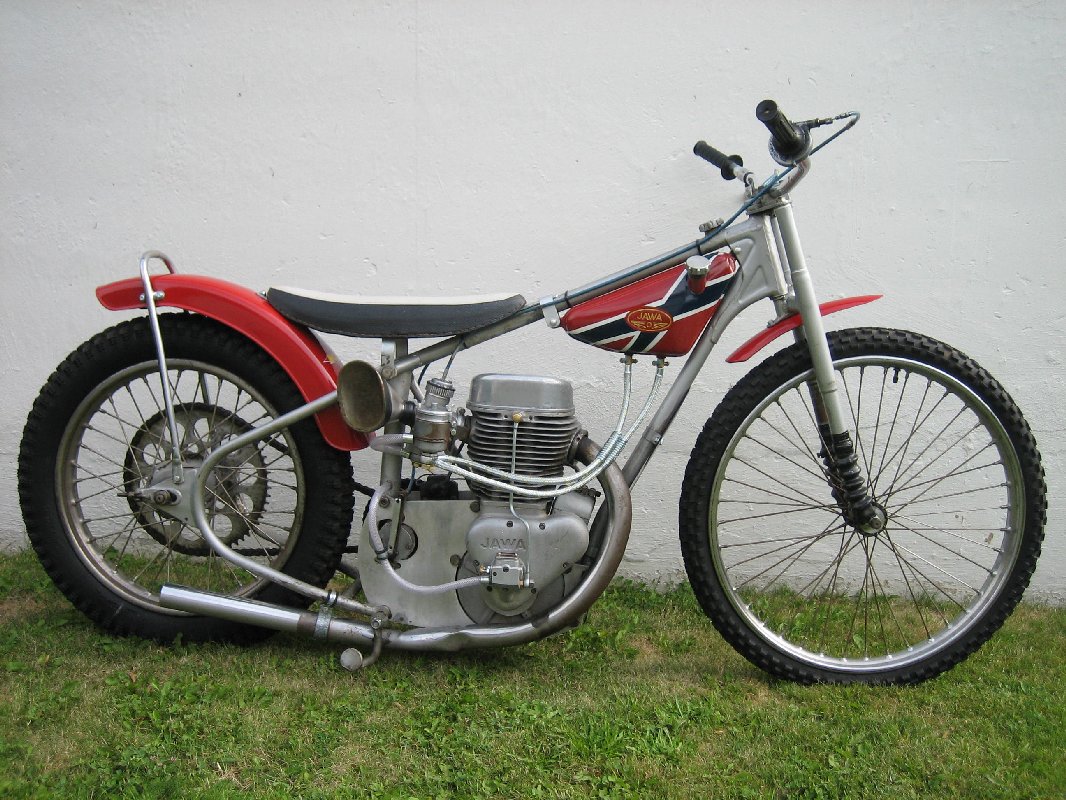 |
| |
| Jawa makes a point of outliving its
opponents. British companies, JAP, Godden and Weslake were all
seen off by the Czech Republic bikes from the JAWA works.
Currently in 2014 we have Jawa and GM. What price JAWA sees off
the Italian GM company too? |
| |
|
| |
| |
Norwegian
Geir Øverby's
JAWA |
| |
Here is an resturatoin objekt
from Norway. It is an 1968 Jawa 890, 2 valves. Regards Geir Øverby,
Kongsvinger
|
| |
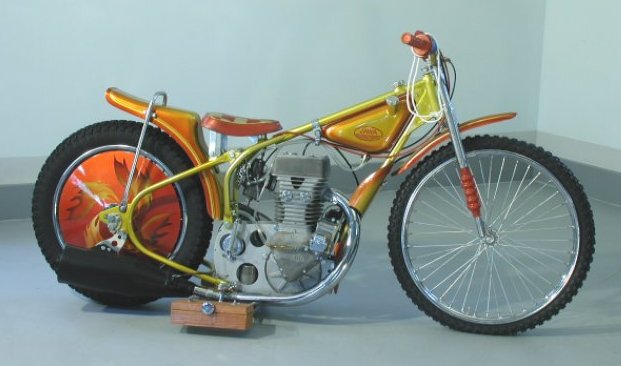 |
| |
| The 1979 Jawa 894 4 valve |
| |
| Hi Geir, your bike looks amazing.
It is far better to look at than the modern laydowns |
| |
|
| |
|
BSA |
| |
| BSA were an armaments maker (BSA =
Birmingham Small Arms) who in the 1900s turned their resources to
motorcycle manufacturing. Over the years BSAs have appeared on
speedway tracks albeit largely unsuccessfully |
| |
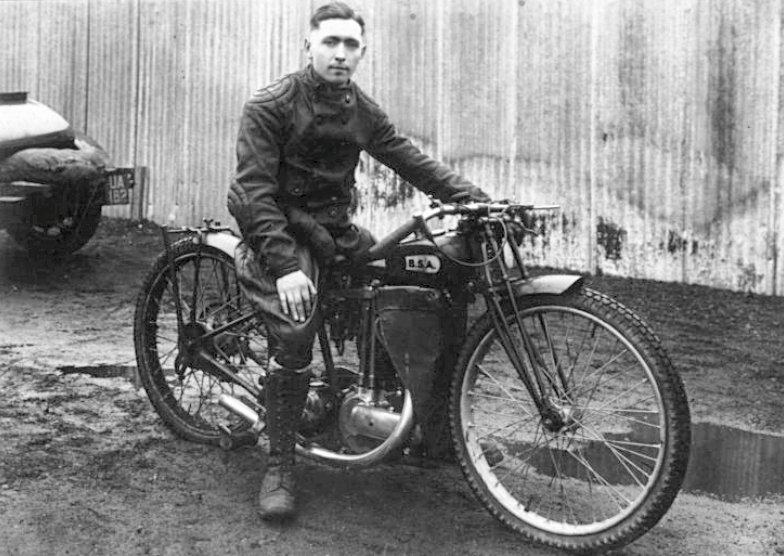 |
| |
| The "poor mans speedway bike" James Carnie aboard a dirt track
BSA complete with back stand and what appears to be the rear brake drum.
The rules of the day said brakes must be made inoperative, so if it was a brake
drum it would have been disconnected. |
| |
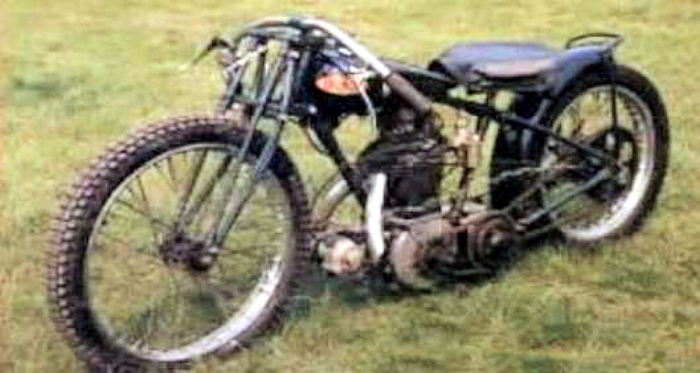 |
|
|
|
A different BSA model with a shorter stroke engine and a lower frame
|
| |
| |
| 1929 BSA Sloper |
| |
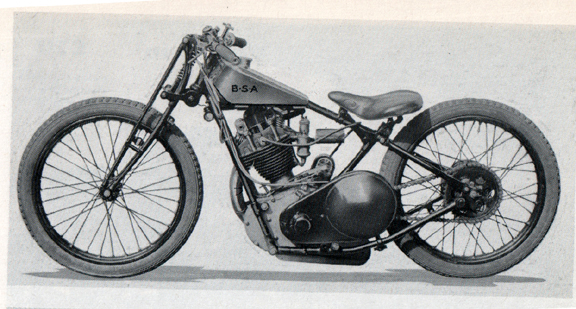 |
| |
| This Beesa had a forward tilted
cylinder. Did the BSA engineer who designed this have a
premonition of Speedway Laydowns in 21st century! |
| |
| |
| BSA's Final Attempt |
| |
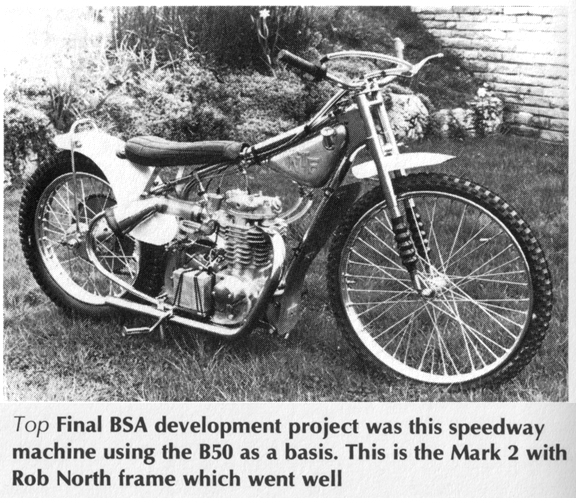 |
| |
|
BSA's Last effort as far as speedway was concerned. We
think this bike was c1970. Did you own one? Do you know of anyone
who raced one? Send me an email if you can help
John |
|
Jim Henry says: Alan Graham
raced a BSA in the 70s. His machine, fully restored with a North frame
is in Scotland. |
| John
says: If anyone can take a picture of it I will put it on this webpage John |
|
Terry Stone says: This bike may have been ridden by
Bill Landells who
rode for Edinburgh or Berwick. |
|
Dan Nichols says: I found your speedway page on
the Internet. You asked for info about the BSA project of the 70s. My understanding is that it was first put into the hands of Nigel Boocock,
riding for Coventry at the time. It was found to be hard to ride (The story
goes that BSA looked at the mild steel and prayer of a Jawa frame, threw up
their hands all horrified and made one out of Proper Steel. It didn't work.),
and ended up falling into the hands of Alan Grahame of Birmingham, then I think
his brother Andy. What happened to it after their time with it, I don't know. |
| |
| John says: And so BSA had a go on a
couple of occasions but their bikes did not turn the heads of the
speedway racing fraternity. A shame as a good BSA speedway bike
might have saved Birmingham Small Arms from closing down? |
| |
|
| |
| |
|
Matchless
|
| |
| Another British bike marque that
dabbled briefly in speedway bike making. |
| |
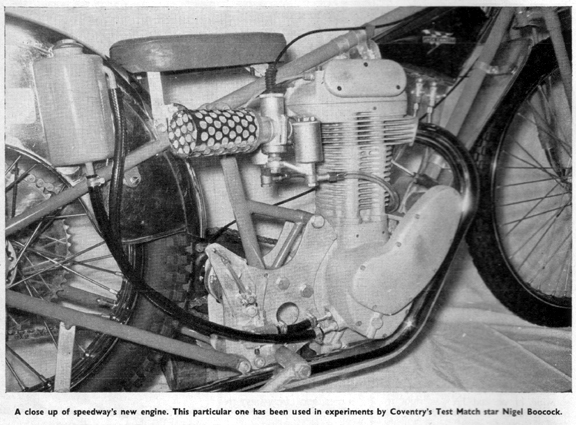 |
| |
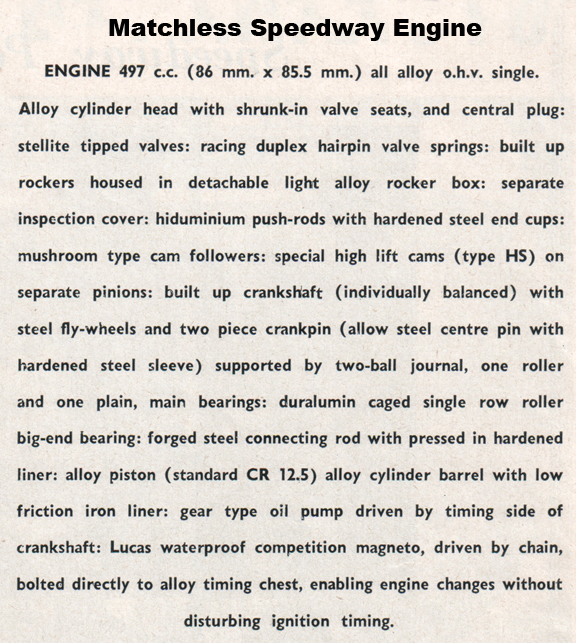 |
| |
| Top
English rider Nigel Boocock experimented with the Matchless in 1965.
Has anyone any photographs or do you know why it wasn't a success
John |
Tony Webb says: -
Jack Emmott
Tuner and MATCHMAKER
builder
Jack Emmott was well known for his connections with developing a Matchless
engine for speedway and the production of his Matchmaker frames, his life was
closely weaved around road racing, grass track and speedway. In fact it was rare
for an engineer to be associated with the completely different disciples of road
racing and speedway as there are very few similarities. Road racing was his
first love but later he switched almost entirely to building frames and tuning
engines for speedway and grass track. |
| |
|
Jack spent most of his working life in London, but he was a West Yorkshire man
by birth, born in Keighley in 1924. He served with the Royal Engineers in
Scotland where he met his wife. They moved south to work for Lord and Lady Bray.
They then moved to Godalming in Surrey where Jack started in the motorcycle
trade working for a local dealer Graham Brown. Australian road racer Bob Brown
loaned Jack the funds to buy a house in London. Bob was later killed in a road
racing accident while practising for the 1960 German Grand Prix in Stuttgart.
Jack had a strong connection with road racing and had many lasting friendships
with road racers. The well known Australian Kel Curruthers, who was 1969 250cc
World champion, stayed at the Emmott's while racing in the UK. |
| |
|
The area of London where Jack lived was known as Little Australia due to the
number of road racing and speedway riders in residence there. Sydneysider, the
late Geoff Curtis and Australian test star Ray Cresp, road racers John Dodds and
Mike Duff and scramblers Roy East and Jack Pringle were all residents of Little
Oz. |
| |
|
An opportunity arose at Associated Motorcycles Company at Plumstead road
Woolwich in the race shop , a chance that Jack grabbed with both hands. It was
there he developed the Matchless G85 CS for speedway with the help of Nigel
Boocock and Malcolm Simmons and also worked on the AJS 7R and the Porcupine.
The G85 CS was developed from the standard G85 series engine that could be
obtained off the shelve from the AMC Woolwich factory. Jack’s
modifications were intended for grass track and speedway but could also be
suitable for Moto cross. The standard cast piston was replaced with a lighter
forge piston more suitable for high compression. Machining 0.25" off the
cylinder base and using plates ratios of 11-14.5 to 1 were obtained. A floating
engine sprocket carrier eliminated primary chain mis-alignment. Under testing
the OHV rocker assembly was found to stress, this was solved by modifying the
camshaft, which did not increase power but it did eliminate valve float and
enabled the use of a lighter valve spring, which in turn benefited acceleration.
|
| |
|
Another modification was the magneto mountings which were located directly on
the rear of the timing case, the engine could then be removed without disturbing
the magneto and timing, the general specification was 497 cc [86mm x 85.5], 50 b
h p on methanol, alloy cylinder head and piston. After a few years with AMC he
joined Swan Vesta, the match making company, as an engineer and that is where
the name Matchmaker was born for his grass and speedway frames. Jack went
into business on his own after leaving Swan Vesta, he gained a reputation as an
excellent tuner and a innovative frame builder. |
| |
|
The Matchmaker frame found its way to all parts of the world. Argentinean rider
George Kisling came to London to collect one, and Australians Jim Ryman and Roy
East both took Matchless engines back to Sydney around 1970. However Matchless
engines were a popular choice for short circuit racing in Australia from the
early sixties. A program I have for a short circuit meeting at Arthur Park in
Brisbane shows 5 Matchless mounted riders including Bob Sharpe, the late Lex
Fielding, George Chadwick, Les McKenna and Matt Niblock. Jacks son Neil recalls
the existence of a log of all the engines and frames that were sold and is
trying to track it down. There were other products that Jack pioneered including
a solid clutch plate to replace the metal plates with a fibre insert which
were used in the AMC clutch. |
| |
Jack also designed a speedway type forks with grass track type rubber band
suspension that were trialled by Australian Ray Cresp and Kiwi Graeme Smith and
found to be very suitable for the rough tracks , that were shared with stock
cars in the early days of the provincial league Jack was the official machine
examiner at West Ham speedway 1964-65, where he gained the respect of the riders
for his fairness and his mechanical knowledge. The stars at West Ham at the time
were Olle Nygren, Ken McKinlay and Malcolm Simmons. Former Canterbury/Crayford
speedway and grasstrack/longtrack rider John Hibben recalled that Jack was a
great mentor to him and tuned his engines for him. Jack Emmott sadly passed away
at the age of 47 in March 1972, he left a legacy in road racing and speedway, he
was truly one of the unsung heroes of motorcycling sport.
Copyright Tony Webb
Brisbane January 2009
binbooks@iinet.net.au |
| |
References and
resources
Neil Emmott son
John Hibben Canterbury rider
Paul Burton. Collector
Speedway star
West ham programs 1964\65 |
| |
|
|
|
|
Royal Enfield
|
| |
| John says: Like BSA, Royal Enfield
started by making firearms before turning to motorbike manufacturing in
the 1900s. Of all the British Bike makers Royal Enfield was my
favourite. I bought an Enfield around 1969 and I loved it! I
believe Royal Enfield was sold to a dealer who sold all the spare parts
for scrap and that was more or less the end of the marque, although
Royal Enfields have been manufactured in Indian recently I believe? |
| |
Royal Enfield
(Speedway) |
| |
 |
| |
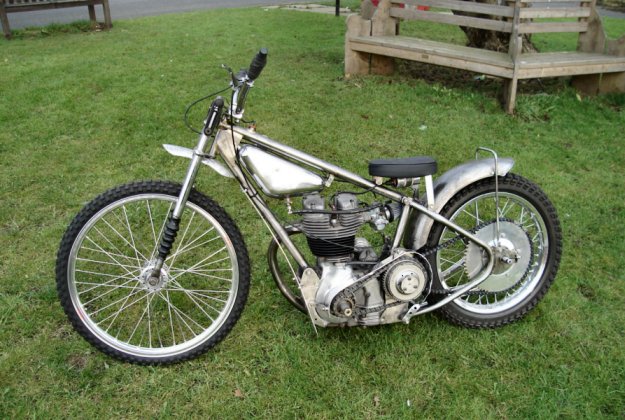 |
| |
|
Dave Ramsden has sent these 2 pictures which show a big single cylinder Royal
Enfield engine and also unusually mounted handlebars. The bike looks pretty
handy though. Wonder how it went? |
|
Dave Says: The Enfield was built primarily for something
to do, not to race. To be honest the Enfield engine is not suitable for
speedway - they are a big heavy engine and not very responsive, though some
people have used them for scrambles. I have no doubt that someone could make
it go faster. I make frames, I leave engines alone wherever possible. It's a
standard 350 Indian Bullet engine that I got in payment for fitting a diesel
engine in a friend's bike. I made the frame, as well as the countershaft and
the engine plates. The wheel hubs and forks came from a grasstrack bike. The
standard Enfield clutch is operated by a BMW clutch arm through the modified
standard main shaft sleeve. The final drive sprocket is bolted to the back of
the clutch on a boss. Apart from the wheel builds and the seat covering I did
everything myself. The frame was TIG welded by my wife.
My regular transport these days is a Russian Ural fitted with a BMW R80/7
engine.
|
| |
| John says: I am a life long
Royal Enfield fan. I would have loved to assist with building Dave's
bike. If Enfield had kept going and made speedway bikes we may
just have had a real bike industry in the UK |
| |
|
| |
|
Bikes Page 1
Bikes Page 2
Bikes Page 3 Bikes
Page 4
Bikes Page 6
Bikes Page 7
|
| |
| |
|
The contents of this website are © and should not be produced
elsewhere for financial gain. The contributors to this website
gave the pictures and information on that understanding. If anyone
has any issue or objections to any items on my website please email me
and I will amend or remove the item. Where possible credit has
been given to the owner of each item. |














































































